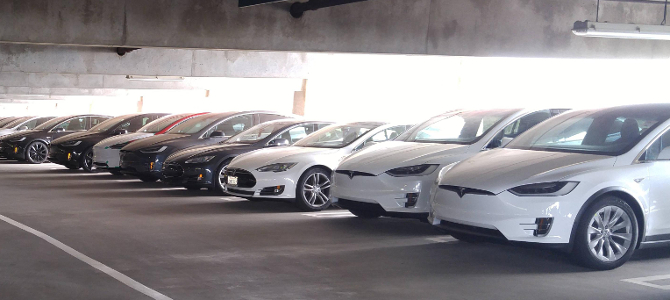
Tesla’s Ghost City?
Tesla has taken a beating in recent months for the quality problems that are affecting the Model X (and to a lesser extent, Model S) as the California electric automaker struggles to scale up. And with Tesla’s production and manufacturing VPs leaving the company and a massive production ramp looming which aims to take the company from 50,000 annual units of production to 500,000 units in a few short years. As Bertel explains over at Forbes, Tesla’s ambitious plans deepen the gulf between it and the real world of automotive manufacturing. But even if Musk can turn a century of automotive expertise on its ear, another challenge awaits that I lay out in my most recent Bloomberg View post:
But even if Musk can whip Tesla into a manufacturing powerhouse overnight, he faces a challenge that no analyst asked him about on Tesla’s quarterly call: whether he can sell all those cars. At the heart of Tesla’s production goal is the assumption that every one of the 400,000 refundable pre-orders Tesla has received so far will translate into the (at least) $35,000 transaction needed to reach the $14 billion revenue goal Tesla is touting for Model 3 reservations. Several outlets have found that the controls Musk said would be in place against speculative bulk pre-orders don’t exist, further increasing the likelihood that a significant percentage of pre-order holders won’t be able to buy a Model 3 when the time comes.
Automakers don’t solicit refundable deposits because production planning is the art of matching supply with demand; overly optimistic demand estimates are the leading killer of car companies. So even if real demand for the Model 3 exceeds every other EV on the market, if Tesla overestimates that demand, the resulting overcapacity will kill its business just as surely as it has countless others.
The refundability and proven lack of safeguards over Tesla pre-orders makes it a highly questionable metric for projecting future demand for the Model 3. Tesla’s reluctance to list its Certified Pre-Owned (CPO) inventory online, preferring to sell it discretely through “CPO Advisors” shows that the firm is struggling to maintain the resale value of unsold cars, which depresses demand for more profitable new cars as it falls. With this circumstantial evidence already demonstrating the extent to which Tesla is trying to prop up demand and pricing on the only two products it has to sell until the Model 3 hits the market, we’ve now found a troubling new data point: this firsthand account of an apparent “graveyard” where (mostly) unregistered Teslas have been sitting and gathering dust, from the Tesla Motors Subreddit (gallery here). The images were reportedly taken on the top floor of a parking garage near Tesla’s Hawthorne, CA facilities, and the poster gives the following background:
Some background – location is a public pay parking structure near Tesla Centinela service center, but only employees of the adjacent office buildings park there.
I’ve visited the structure in the past, and usually 110v slow charge my Fiat 500e on a lower level. Unfortunately, the plug was not working so I tried another outlet on the higher levels. When I got up there, I about lost my mind to see so many Teslas.
Some spaces were marked as reserved for Tesla, but many were not. For funsies, I parked my 500e in between. I’d estimate there were 40 Teslas one day, and maybe 50-60 another.
Many of the X still had their original window sales sticker on the dash, most all cars had a barcode sticker in the top windscreen corner. Some noted “customer car” on a tag hanging. I saw a couple cars that seemed to be dated February 2016, hence the large amount of dust accumulated.
We are not yet able to verify this account, nor have we identified the location or confirmed the purpose of this Tesla “ghost city,” but it’s disturbingly similar to images from the 2008 downturn when automakers sent unsold cars into storage. We will continue to investigate, but at this point to seems fair to say that Tesla’s real demand-side deserves as much scrutiny as its supply side.





